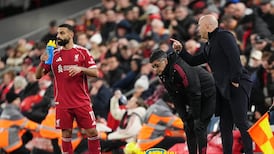‘I was due to take Robin off after 60 or 70 minutes, but I think if I’d taken him off everyone would have said: ‘What are you doing?’ But in truth Robin needed to come off after 70 minutes maximum, but I had to keep him on. We were chasing the game, we had to get a goal back.”
You could see David Moyes’s point. His gamble nearly came off when van Persie stuck a header in the net only to be ruled offside. Imagine the howls of outrage if he’d hooked him with 20 minutes to go.
But a man in Moyes’s position has to be prepared to make unpopular decisions. Van Persie’s injuries have been the biggest single reason why Manchester United’s title defence has collapsed. His fitness should be Moyes’s top priority, above even getting an equaliser against Newcastle.
Moyes described rumours that Van Persie had requested a transfer as "absolute nonsense," but you don't need a dressing-room spy to know that something is up with the player. You just have to look at his appearance record. He's missed one-third of United's league matches and they haven't won in the league when he hasn't played.
Injury problems
Van Persie used to be seen as "injury-prone" until he played 90 consecutive league matches between March 2011 and September 2013. The question of whether the return of his injury problems is linked to the Moyes training regime – described by Wayne Rooney as "a lot more running: long running, quicker running, sharper running" – has become a matter of speculation.
The Dutch fitness coach Raymond Verheijen has fiercely criticised Moyes since the day last summer when Moyes said of Van Persie: "We have overtrained him this week to try and make sure we build up his fitness but he has never complained about a thing."
Verheijen didn’t like the word “overtrained”.
“The only way to solve this problem in Jurassic Park is to improve education of these dinosaur coaches, fitness clowns and scientific cowboys. All over the world in preseason you see the pattern overtraining-fatigue-injuries’. . . Obviously, players like RVP should learn to protect themselves better against ‘overtraining’,” he said.
Verheijen has a good reputation in the game, having trained South Korea's 2002 World Cup team and the Russian side of Euro 2008, both of whom won plaudits for their fitness. One Verheijen disciple, Craig Bellamy, describes him as "difficult" and "arrogant", but says, "he has an annoying habit of being right about fitness issues".
Like Van Persie, Bellamy overcame a reputation for injury-proneness in the latter stages of his career. His book Goodfella contains fascinating insights into the training methods of certain Premier League clubs.
Fans tend to assume Premier League fitness training must be state of the art but, according to Bellamy, that’s not the case. He says his form during his first spell at Liverpool in 2006-’07 suffered because of the training methods of Rafa Benitez and Pako Ayesteran. Like Moyes, they prescribed plenty of running.
"I am a fast-twitch fibre player and I was plodding around the perimeter of the training complex," Bellamy writes. "I felt like I was being trained to get a decent time in a marathon, not to sprint away from a central defender. . . Pako said they wanted to take some of my speed off and bring my endurance up. I knew if they did that, they would lose me as a player . . . I never felt more unfit in my life . . . On a Friday before a game, we would be doing heavy lifting squats and that took a lot out of my legs. I was actually being detrained."
Refusal to train
At Manchester City, Bellamy fell out with Roberto Mancini over his refusal to do double training sessions. Bellamy argued his knees and hamstrings couldn't take so much training; Mancini assumed he was lazy. The coach had the old-fashioned attitude to training: what doesn't kill you makes you stronger.
Many fitness coaches now believe overtraining is as bad as no training. In the William Hill-nominated book The Sports Gene, physiologist Jesper Andersen tells author David Epstein that on average, footballers in the Danish first division have a lower proportion of fast-twitch fibres in their muscles than does the man in the street. Since pace is the most-prized physical attribute in football, how can this be?
Andersen blames football’s one-size-fits-all training methods. Fast-twitch fibre players shouldn’t train as much as slow-twitch fibre ones, but in football everyone usually does the same training. Andersen discovered that the Danish youth ranks were full of fast-twitch fibre players, who were mostly weeded out by chronic injuries before the age of 18. You wonder how many of them were written off as “injury-prone” – football’s way of blaming the victims.
Verheijen had another pop at Moyes on Saturday: “The training method of this coaching staff is prehistoric . . . In 7 of 9 seasons at Everton: injury crisis after pre-season and very poor start of season. This pattern has clearly repeated itself . . .”
That may be unfair to Moyes. When you analyse Everton’s injury record in his time there, the clearest trend is a sharp drop in the overall number of injuries, from a high of 69 in the calendar year 2004, to a low of 37 in 2011, suggesting the fitness regime had improved. In the case of Van Persie, though, further improvements are needed, and Moyes has no time to waste.












